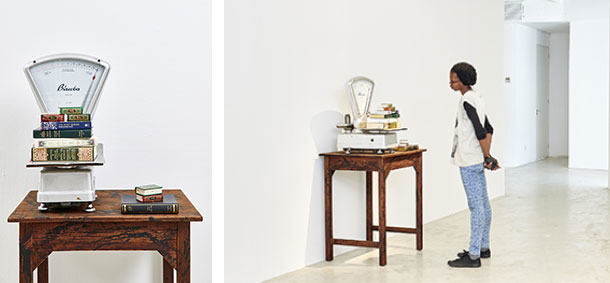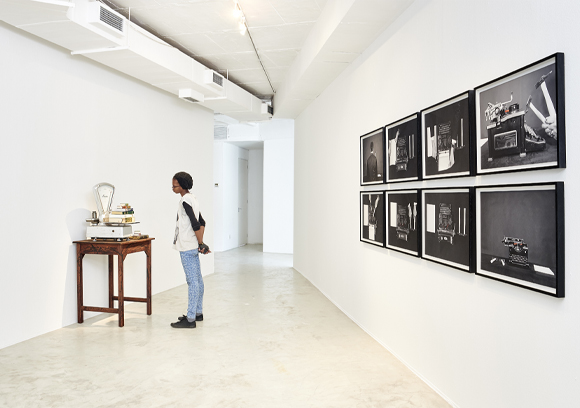| |
|
|
46.
| The Weight |
| |


2017, Found objects, Variable.
Exhibition view from Fragmented Memory, Goodman Gallery, 2017, Johannesburg.
Courtesy of the artist.
Ed. of 5 + 1 A.P.
'' The sculpture questions the influence of books and ideology, adopting a scientific approach tinged with humor and a sense of the absurd...
it poses the question of the power of the words of religion and of the religious message, by bringing science and faith face to face. ''
Studio Fatmi, February 2017

The Weight
Exhibition view from Fragmented Memory, Goodman Gallery, 2017, Johannesburg.

The Weight
Exhibition view from Fragmented Memory, Goodman Gallery, 2017, Johannesburg.
|
|
|
|
|
|
Le Poids est une œuvre sculpturale composée d'une table en bois sur laquelle repose une ancienne balance commerciale, dont le plateau supporte une pile de livres constituée de plusieurs exemplaires du Coran, aux formats variés et rédigés dans différentes langues. Le livre est un matériau récurrent des œuvres de mounir fatmi où ses pouvoirs ambivalents de diffusion et de contrôle des idées sont étudiés. L'association du livre (ou d'un langage) et de la machine est observable dans d'autres réalisations telles que « Le paradoxe », « Technologia », ou encore « La Machine et l’Index » qui traite de la naissance de l'imprimerie et décrit la manière dont cette invention a révolutionné l'écriture, la culture et l'histoire des idées en permettant leur diffusion, mais également entraîné des phénomènes de censure massifs et sans précédent, avec des modèles de publication imposés à grande échelle.
La sculpture interroge les influences du livre et de l'idéologie, à partir d'une approche scientifique traitée sur un mode humoristique ou absurde. Tentative de pondérer l'impondérable, de se saisir d'un élément immatériel et insaisissable, Le Poids pose la question du pouvoir des mots de la religion ou du message religieux en confrontant science et croyance.
Le Poids s'inscrit dans une stratégie du ready-made, élaborée par mounir matmi à travers différentes sculptures (telles que « Sans Histoire » ou « Civilisation », employant également le livre). Celle-ci consiste en la juxtaposition d'éléments hétérogènes, scientifiques et religieux, dans le but de questionner les pouvoirs des objets présentés, à la fois en les confrontant l'un à l'autre (pouvoir de l'idéologie religieuse contre pouvoir critique de la science), et en les associant (livre et balance étant envisagés tous deux comme des formes de machine). La sculpture participe à une démarche de questionnement de la pensée dogmatique et de démystification ou désacralisation des objets de croyance. Le dispositif artistique déleste ainsi pour un temps les ouvrages religieux de leur charge idéologique et permet une réflexion sur le poids des mots, dont la valeur est paradoxalement très variable : les mots de la doctrine religieuse ont une charge considérable, pesant sur l'histoire des idées et sur les consciences à travers les époques et les sociétés ̶ et pourtant, il ne s'agit que de mots, dont la masse réelle et matérielle est en réalité nulle, et qui n'acquièrent de charge ou d'effet qu'à condition de croire en leurs pouvoirs.
La sculpture « Le Poids » joue avec les mots. L'œuvre évite l'écueil du sérieux et de la soumission aux pouvoirs de la religion ou de la science en optant pour l'humour et un questionnement teinté d'absurde permettant de maintenir la juste distance par rapport à ces forces et autorisant ainsi leur observation.
Studio Fatmi, Février 2017. |
|
« The Weight » is a sculptural work comprising a wooden table on which is placed an old weighing scale, its platter supporting a pile of books: several copies of the Koran in various formats and written in different languages. Books are a recurrent material in mounir fatmi’s work, where their ambivalent power in terms of the circulation and control of ideas is studied. The association of books (or languages) and machines can be seen in other of his pieces such as « The Paradox », « Technologia » and « The Machine and the Index », which is about the birth of the printing press and describes how that invention revolutionized writing, culture and the history of ideas by allowing their circulation, but also how it generated phenomena such as massive and unprecedented censorship, with publishing models imposed on a large scale.
The sculpture questions the influence of books and ideology, adopting a scientific approach tinged with humor and a sense of the absurd. « The Weight » is an attempt to weigh the unweighable and to seize an immaterial and unseizeable element; it poses the question of the power of the words of religion and of the religious message, by bringing science and faith face to face.
« The Weight » is part of a strategy of the ready-made elaborated by mounir fatmi across various sculptures such as « Without History » or « Civilization », which also uses books. This strategy consists in juxtaposing heterogeneous elements, both scientific and religious, in order to question the power of the presented objects by bringing them face to face (the power of religious ideology vs. the critical power of science) but also by associating them (the books and the weighing scale are both seen as a type of machine). The sculpture is part of an approach questioning dogmatic thinking and demystifying or desacralizing objects of faith. In this way, the artistic process temporarily removes the ideological charge of religious objects and enables a reflection upon the weight of words, which paradoxically have highly variable value: words of religious doctrine are considerably charged, weighing upon the history of ideas and on consciences throughout eras and societies – nevertheless, they are just words whose real and material mass is in reality equal to zero, and they only acquire a charge or an effect when people believe in their power.
The sculpture « The Weight » plays on words. It steers clear of the pitfalls of seriousness and the submission to the power of religion and science by choosing humor and a form of questioning tinged with absurdity, creating the right distance vis-à-vis those powers, thus allowing their observation.
Studio Fatmi, February 2017.
|
|
|
|